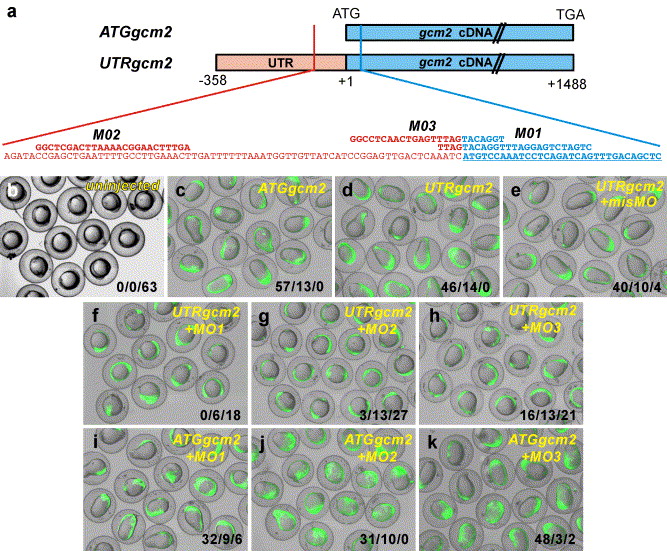Fig. 4 Validation of gcm2 morpholino oligonucleotide activity. (a) Representation of reagents used in a two-injection rescue experiment. Two pCS2+-based constructs were built to enable synthesis of two different gcm2 capped mRNA transcripts. The ATGgcm2 mRNA contained the full gcm2 coding sequence but did not include the full binding sites for any of the morpholino oligonucleotides used. The UTRgcm2 mRNA contained 5′ UTR and the full gcm2 coding sequence and the full binding sites for the morpholino oligonucleotides MO1, MO2 and MO3. UTR is represented in red, coding sequence in blue. (b?k) Rescue of the gcm2 overexpression phenotype occurred only in the presence of complete morpholino oligonucleotide binding sites. In this experiment, test mRNA (50 or 100 ng/μL) was injected at the 1?2 cell stage and morpholinos injected via a second separate needle at the 2?4 cell stage. mRNA encoding enhanced green fluorescent protein (EGFP) was co-injected (15 ng/μL) with test mRNA as a tracer of mRNA delivery and as a further specificity control. Injections of ATGgcm2 and UTRgcm2 mRNA resulted in a highly reproducible early axis-patterning defect (c, d), which was not rescued by a separate, second injection of the mis-matched control morpholino (misMO) (e) and was not observed in uninjected embryos (b). A second separate injection of MO1, MO2 or MO3 rescued the overexpression phenotype in UTRgcm2 mRNA injected embryos (f?h) but not in ATGgcm2 mRNA injected embryos (i?k), nor did any morpholino affect EGFP expression. Combined scores from two separate experiments are shown in the bottom right of each panel in three categories of phenotype severity: grossly elongated embryos/mildly dysmorphic embryos/phenotypically normal embryos. Merged false color images are shown, with green indicating the presence of EGFP.
Reprinted from Developmental Biology, 276(2), Hogan, B.M., Hunter, M.P., Oates, A.C., Crowhurst, M.O., Hall, N.E., Heath, J.K., Prince, V.E., and Lieschke, G.J., Zebrafish gcm2 is required for gill filament budding from pharyngeal ectoderm, 508-522, Copyright (2004) with permission from Elsevier. Full text @ Dev. Biol.

